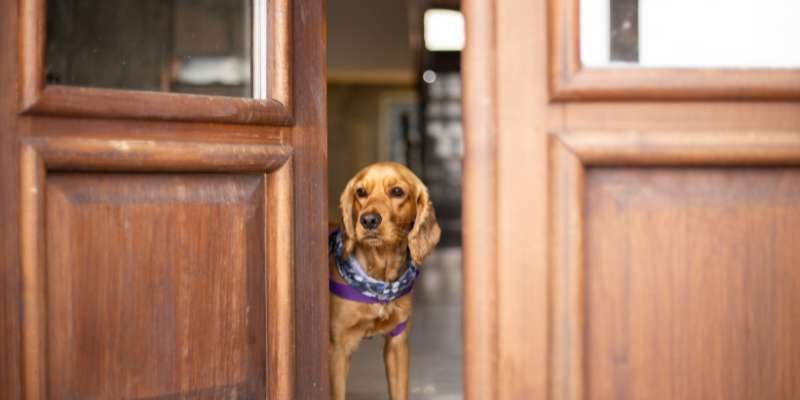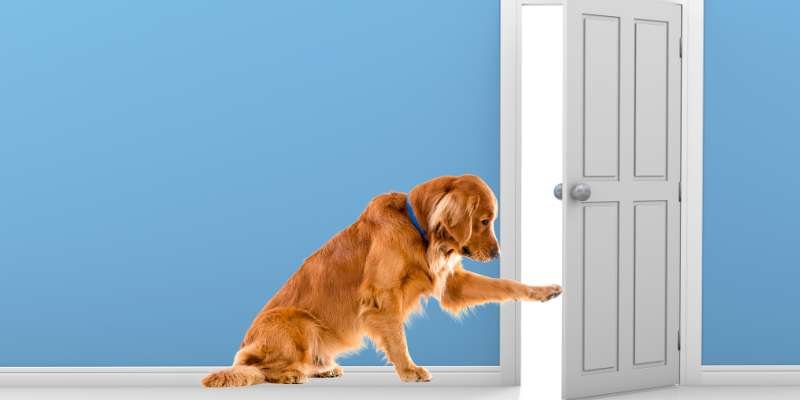Ever wondered How do dogs know how to open doors? Let’s dive into the adorable mystery of our furry friends’ door-opening skills. Picture those cute noses poking at handles and playful paws figuring out knobs. It’s not just random; there’s a mix of natural instincts and cleverness at play. This blog will take you on a journey through the simple yet heartwarming moments where your dog, with a wagging tail, becomes the master of doors. Get ready to smile at the charming antics and feel the warmth of the unique bond between you and your four-legged pal as they unveil the secrets behind the door-opening magic.
How dogs know how to open doors?
Dogs learn to open doors through a combination of their natural curiosity, problem-solving skills, and observational learning from humans. Their innate instincts, coupled with positive reinforcement and breed-specific traits, contribute to their ability to experiment with door-opening actions and discover effective solutions.
Reasons Why Your Dog Can Open Doors
Curiosity and Natural Instincts:
Dogs are inherently curious creatures. Their natural instinct to explore and understand their surroundings motivates them to investigate and interact with various objects, including doors. The tactile experience of manipulating door handles or pawing at doors is intriguing for them.
Observational Learning:
Dogs are keen observers, and they learn by watching their human companions. If a dog witnesses you opening doors frequently, they may attempt to imitate the action. This form of observational learning plays a significant role in their ability to understand and replicate door-opening behavior.
Problem-Solving Skills:
Dogs possess impressive problem-solving abilities. When faced with a closed door, especially if it stands between them and a desired location or activity, dogs engage their cognitive faculties to find a solution. Through trial and error, they may discover that certain actions lead to the door opening.
Positive Reinforcement:
Dogs are motivated by positive reinforcement. If a dog successfully opens a door and gains access to a desired area, they associate the action with a positive outcome. This reinforcement strengthens the behavior, encouraging them to repeat the action in the future.
Breed-Specific Traits:
Certain dog breeds are known for their intelligence, persistence, and problem-solving abilities. Breeds like Border Collies, German Shepherds, and Poodles, for example, may be more predisposed to mastering the skill of opening doors due to these inherent traits.
Desire for Access and Exploration:
Dogs have specific areas they may want to access, whether it’s the backyard, a particular room, or where their human family members are located. The desire for exploration and social interaction can drive dogs to figure out how to open doors to satisfy their needs.
Environmental Influence:
The environment in which a dog is raised plays a crucial role. If doors are frequently opened and closed in their surroundings, dogs become more familiar with the concept and may be inclined to experiment with doors. Consistent exposure to doors contributes to their understanding of the mechanisms involved.
Attention-Seeking Behavior:
Some dogs learn that opening doors attracts attention. If they receive a reaction, whether positive or negative, from their human family members when engaging with doors, they may continue the behavior as a way to seek attention and interaction.
Understanding these reasons can help dog owners manage and redirect their pets’ door-opening behavior through appropriate training and reinforcement strategies.
How to Know If a Dog Wants to Open the Door?
FAQs about how do dogs know how to open doors
Can dogs learn how do you open doors?
Dogs can learn to open doors through observation and mimicry. If they witness humans opening doors, especially those with handles or levers, they may attempt to replicate the action. Positive reinforcement can further encourage this learned behavior.
How does the dog know who is at the door?
Dogs rely on their acute senses, particularly their sense of smell and hearing, to identify individuals at the door. Familiar scents and sounds associated with family members or frequent visitors enable dogs to recognize who is approaching.
How do dogs know to scratch the door?
Scratching is a natural canine behavior driven by instincts and communication. Dogs may scratch doors to signal a desire to go outside, gain attention, or express anxiety. This behavior often develops through association and reinforcement of a specific response.
Why do dogs try to open doors?
Dogs attempt to open doors for various reasons, including curiosity, seeking companionship, or accessing different areas. It’s a combination of their natural explorative instincts, problem-solving abilities, and learned behaviors from observing human actions.
Is my dog smart if he can open doors?
Yes, a dog opening doors showcases intelligence, problem-solving skills, and adaptability. Dogs with this ability often display a higher level of cognitive understanding, especially if they’ve learned to associate specific actions with desired outcomes through observation and reinforcement.
Why do dogs hate closed doors?
Dogs may dislike closed doors due to separation anxiety, a desire for social interaction, or a need for exploration. Closed doors can represent barriers to their natural instincts and create frustration. Ensuring ample mental stimulation and addressing underlying issues can help alleviate this dislike.
Conclusion: How do Dog learn to open doors
In conclusion, the mystery of how dogs know how to open doors can be attributed to a combination of their natural instincts, problem-solving abilities, breed-specific traits, and environmental influences. Dogs, being highly adaptive and observant animals, learn by exploring and imitating the actions of their human companions. As we continue to marvel at the intelligence of our canine friends, it’s essential to understand the various factors that contribute to their remarkable ability to navigate the human world, one door at a time.






